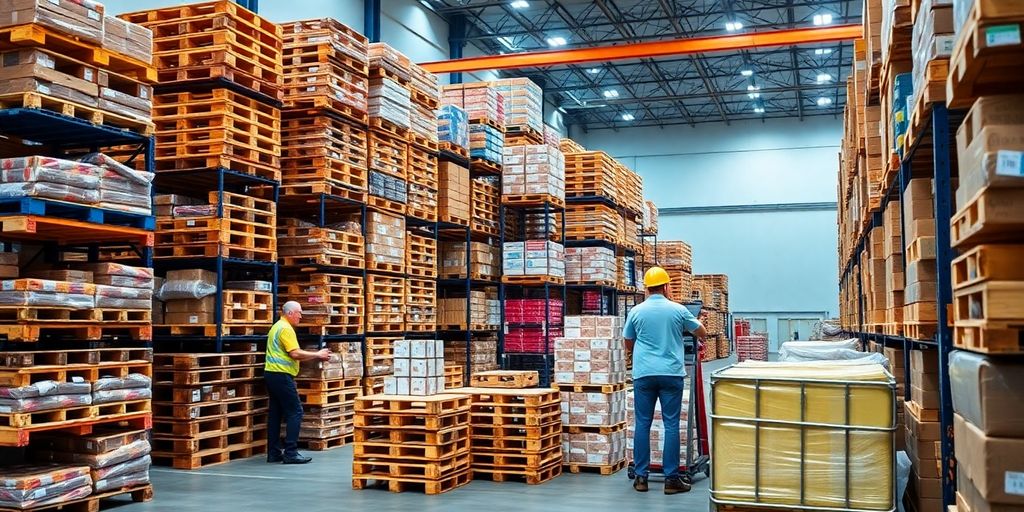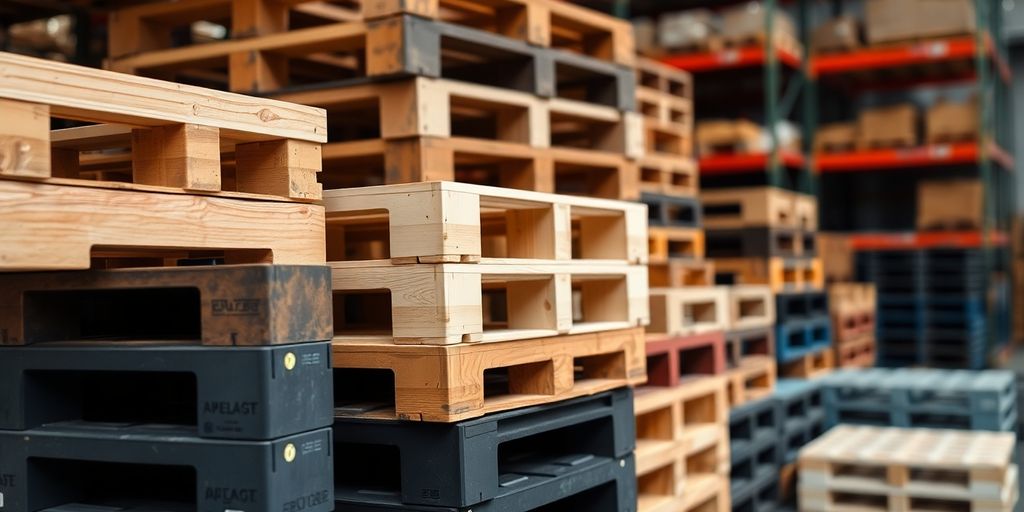Attempting to understand pallet prices in the UK? You are not alone. Is a bit of a maze out there with all sorts of factors affecting the cost. Whether you’re a:
- business owner
- or just someone curious, understanding how much you might spend on pallets can be useful.
From the type of pallet to where you’re buying them:
- prices can swing quite a bit. Let us also consider the eco-friendly options that are becoming increasingly available.
Understanding Pallet Prices in the UK
Factors Influencing Pallet Prices
When speak about pallet prices in the UK, several factors come into play. Material type is one of the primary determinants. Wooden pallets, for instance, are generally cheaper than plastic ones, but they might not last as long.
The euro pallet price can also vary based on the quality and treatment of the wood. Another crucial aspect is the size and weight capacity of the pallet. Larger and more robust pallets naturally cost more. Where can you get free pallets this is one huge question. Furthermore, market demand and supply dynamics can influence prices:
- especially during peak seasons when logistics activities are at their highest.
Comparing New and Used Pallet Costs
Choosing between new and used pallets depends largely on your budget and needs. New pallets, while more expensive, offer the advantage of reliability and do unique. They can be tailored to specific:
- dimensions
- and load capacities.
On the other hand, used pallets are significantly cheaper—sometimes up to 60% less than their new counterparts. This makes them an attractive option for businesses looking to cut costs. For example, the euro pallet cost for used options typically ranges from £4.50 to £9.90, offering substantial savings.
Regional Variations in Pallet Pricing
Pallet prices aren’t uniform across the UK. Regional differences can lead to price variations because factors like:
- transportation costs,
- local demand,
- and availability of raw materials. In urban areas, where the demand for pallets is higher, prices might be slightly elevated compared to rural regions. Additionally, proximity to manufacturing hubs or ports can also affect pricing, as it impacts:
- the logistics
- and distribution costs associated with delivering pallets to end-users.
Types of Pallets and Their Costs

- standard pallets,
- euro pallets,
- or something more specialised, knowing the price range can help make informed decisions.
Wooden Pallet Price Range
Wooden pallets are the go-to choice for many because their accessible and durability. New wooden pallets typically range from £3.90 to £15.90 each, depending on standard size and load capacity. Used wooden pallets, on the other hand, can be a more budget-friendly option:
- costing roughly 60% less than new ones, with prices from £4.50 to £10.90.
- New Wooden Pallets: £3.90 – £15.90
- Used Wooden Pallets: £4.50 – £10.90
Plastic Pallet Price Considerations
Plastic pallets are gaining popularity for their long lifespan and resistance to weather conditions. They are generally more expensive than wooden pallets. with prices starting from £10 and can go upwards based on the specifications and durability needed.
- Advantages: Longer lifespan, weather-resistant
- Detriment: Higher initial cost
Specialty Pallets and Their Pricing
Specialty pallets, including heat-treated and press wood pallets, offer unique benefits for specific applications. Heat-treated pallets are ideal for international shipping, ensuring compliance with:
- GOV regulations,
- and usually cost about £1-£2 more than standard pallets. Press wood pallets are:
- lightweight
- and stackable, often used for export purposes, and their prices vary widely based on unique needs.
When selecting a type of pallet, consider both the upfront cost and the long-term benefits. Investing in the right pallet type can lead to significant savings and efficiency in your supply chain.
How to Get the Best Pallet Price
Tips for Negotiating Pallet Prices
Negotiating pallet prices can seem daunting, but it’s essential for securing the best deal. Start by doing your homework—understand the average market prices and the going rates for both new and used pallets.
This knowledge gives you a strong foundation in negotiations. Do not hesitate to request discounts, particularly if you are purchasing in large quantities. Suppliers often have room for negotiation, particularly if you can guarantee regular business. Is also worth mentioning any competitor’s quotes you’ve received, as this can sometimes lead to better offers.
Finding Discounts and Deals
Finding the right discounts and deals can significantly reduce your pallet costs. Start by subscribing to newsletters from pallet suppliers, as they often send out exclusive offers to their subscribers. Look for:
- seasonal sales
- or clearance events, which can be a great opportunity to score high quality pallets at a reduced price. Consider joining trade groups or online forums where businesses share discount codes and tips on where to find the best deals.
Choosing the Right Supplier
Selecting the right supplier is crucial for getting the best pallet price. Look for suppliers with a reputation for quality and reliability. High quality pallets not only last longer but also save money in the long run.
Evaluate suppliers based on their customer service, delivery times, and the range of pallets they offer. Don’t just settle for the cheapest option without considering these factors, as it might lead to additional costs down the line. Always check reviews and possibly even visit the supplier to ensure their operations meet your standards.
The Impact of Pallet Prices on Businesses
Cost-Effectiveness of Different Pallet Types
Choosing the right type of pallet, standard pallet sizes , can significantly affect your business’s bottom line. Wooden pallets are generally cheaper upfront compared to plastic or metal options. However, they may not last as long, especially in harsh conditions.
Plastic pallets, while more expensive, offer:
- durability
- and can be reused many times, potentially saving money in the long run.
Metal pallets are:
- the most durable but come with a higher price tag, often reserved for specific industries with stringent safety requirements.
Additional Costs to Consider with Pallets
When budgeting for pallets, it’s essential to factor:
- in not just the base price but also various additional expenses that can crop up.
These costs can significantly impact the overall:
- expenditure
- and should be considered carefully.
Delivery and Shipping Costs
Transporting pallets from one location to another can add , especially if you’re dealing with international shipments. Delivery fees often depend on distance, the number of pallets, and specific delivery requirements. For instance, if you need a timed delivery, this might incur extra charges. Is wise to compare different courier services to find the best rates.
Maintenance and Repair Expenses
Over time, pallets can suffer wear and tear, especially if they’re frequently used or subjected to heavy loads. Regular maintenance is crucial to ensure safety and functionality. This might include replacing broken boards or reinforcing weak spots. Investing in proper maintenance can extend a pallet’s lifespan, saving money in the long run.
Add-Ons and unique Fees
Sometimes, standard pallets might not meet your specific needs, and unique becomes necessary. This could include change to support a higher load capacity or adding protective wraps. Additional services like heat treatment or special coatings can also increase costs. Is important to evaluate whether these add-ons are necessary for your operations.
Consider all potential costs associated with pallets to avoid unexpected expenses. While the initial price is a key factor, overlooking additional charges can lead to budget overruns. Planning ahead and understanding these costs can help in making informed decisions.
 Conclusion
Conclusion
In summary, understanding pallet prices in the UK can be a bit of a maze, but it’s not impossible. Whether you’re after new, used, or even heat-treated pallets, there’s a range of options to fit different needs and budgets.
Frequently Asked Questions
What affects the price of pallets in the UK?
The price of pallets in the UK can vary based on factors such as the type of pallet, its size, and the materials used. New pallets tend to cost more than used ones, and additional treatments or unique can also impact the price.
FAQ(Frequently Asked Questions)
What affects the price of pallets in the UK?
The price of pallets in the UK can vary based on factors such as the type of pallet, its size, and the materials used. New pallets tend to cost more than used ones, and additional treatments or unique can also impact the price.
How much do wooden pallets typically cost?
In the UK, wooden pallets can range from about £5.95 to £26.50 each. Used wooden pallets are often cheaper, sometimes costing up to 60% less than new ones.
Are plastic pallets more expensive than wooden ones?
Yes, plastic pallets generally cost more than wooden pallets. New plastic pallets can range from £8 to £40, depending on the supplier and specifications.
Can I save money by choosing used pallets?
Absolutely! Used pallets are a cost-effective option:
- often costing significantly less than new ones while still providing good quality for storage and shipping needs.
What are heat-treated pallets, and how much do they cost?
Heat-treated pallets undergo a process to remove harmful chemicals or pests, making them safer for international shipping. They typically cost approximately £1-£2 more than standard.
Where can I find affordable pallets in the UK?
Affordable pallets can be found at various suppliers across the UK:
- including DIY stores
- and specialised pallet companies. Some places might even offer free pallets if they have extras available.





